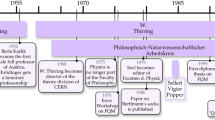Abstract
My paper considers the impact of the early Solvay meetings from a perspective of popularization, i.e. looking at audiences besides science. In asking “Who made quantum theory popular?” I investigate whether this unusual congress introduced a kind of mechanism — institutional, disciplinary, popularizing or other — that had been recognized and applied also elsewhere.
My interpretation of the early Solvay conferences, on the one hand, dispenses with linear stories often found with older accounts, e.g. that the Solvay meetings Nos. 1, 2 and 5 supposedly laid the foundations of quantum theory altogether. On the other hand, I attempt at dispelling the “three miracles” Peter Galison (2007) has found in the history of the first Solvay meeting. He was right to stress that the meetings were not so much spectacular turning points in the history of physics but rather “served as sites for powerful reviews of the field” and were “catalysts for intellectual and social networks”. However, neither the “precise balance between two philantropic forces” in Ernest Solvay’s motivation, nor Lorentz’s brilliant guidance of the discourse, nor the “presence and prior contributions” of Einstein, I would like to be willing to qualify in any way as miracles. There were good reasons, I argue, to give Lorentz the role he filled, and to invite Einstein; also Nernst may have made it clear enough to Solvay, what role would give him the most appreciation.
My thesis is that the success of the first Solvay meeting did not much rely on miracles, but was a successful unfolding of a meticulously devised model — call it the Solvay model, or probably more accurately, the Nernst model. This model can be characterized as an externally-funded, agenda-setting, high-profile and international meeting of scientists concerned with one novel scientific problem or field, where select pre-circulated papers of some participants were discussed with more invited discussants, and later its papers and discussions were published for reaching a broader scientific audience as well as informing a more general audience, and all this with the aim to have follow-up meetings as well as a grant giving institution promoting research in the chosen field.
For such a model, it obviously needed a Nernst, a Solvay and an interested scientific community, or to put it more generally, an organizer driven by a scientific problem he had encountered and which he wanted to dominate, a Philantropy that can offer funds and institutional resources, and also some disciplinary space, within which a new scientific subfield can be established. I test this model with two cases, which may be called Solvay 1.5 and Solvay 16.5, relating to high-profile meetings at Göttingen in 1913 and San Francisco in 1977.
Similar content being viewed by others
Author information
Authors and Affiliations
Corresponding author
Rights and permissions
About this article
Cite this article
Schirrmacher, A. Who made quantum theory popular with physicists and beyond?. Eur. Phys. J. Spec. Top. 224, 2113–2125 (2015). https://doi.org/10.1140/epjst/e2015-02526-1
Received:
Revised:
Published:
Issue Date:
DOI: https://doi.org/10.1140/epjst/e2015-02526-1




